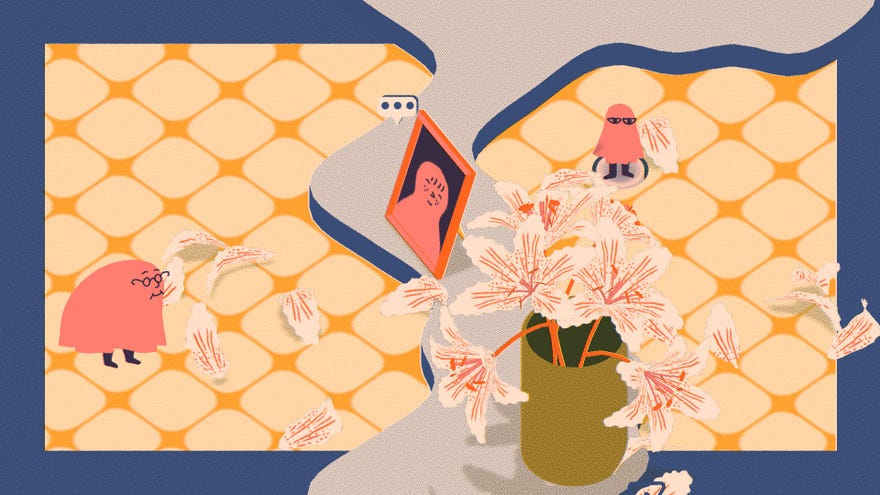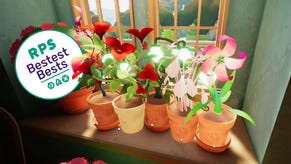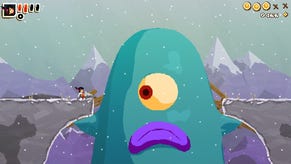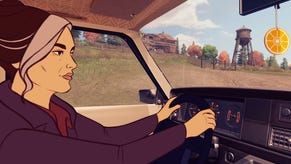How To Say Goodbye review: a cozy, compassionate puzzle game about death
Pushing up daisies
How To Say Goodbye starts with someone dying. It’s not shocking or distressing; quite the opposite. The person died in a hospital bed surrounded by their closest friends and family, and after they've passed on the group begins to share stories and memories from when they were alive. Death isn’t always this calm and it isn’t always this peaceful, but on rare occasions it can be.
This is how developers Florian Veltman and Baptiste Portefaix have approached death in How To Say Goodbye, a cosy game that explores the topic with kindness and sensitivity. With its paper doll illustrations and pastel colour palette, it kinda feels like a children's pop-up book that teaches kids about grief. It’s not overly sweet or patronising, just a gentle game about a group of ghosts who discover how to mourn, how to accept their own death, and how to move on.
It sounds somber, but I promise it’s not! How To Say Goodbye is more than two-and-a-bit hours of grief counselling. It’s funny, goofy, and pretty positive about all the death stuff. The story follows a group of ghosts who are stuck in a liminal in-between space of life and death. Each ghost is looking for a way to reach the 'other side' and there’s also a Wizard who’s a complete jerk trying to stop them.
Each puzzle tasks you with moving your ghost cohort from one side of an environment to the other, usually picking up keys and standing on buttons to unlock doors and passages as you go. You do this by clicking and dragging the tiles around the characters in a sort of conveyor belt system that has horizontal and vertical movement.
How To Say Goodbye is more than two-and-a-bit hours of grief counselling. It’s funny, goofy, and pretty positive about all the death stuff
It’s a neat idea, and puzzles are never anything more than breezy brain ticklers at most, but the controls are super finicky. Moving the grid can be incredibly clunky, and with the more complex puzzles that require precision, it completely pulled me out of the game. I think slow and steady is the key here, as when I tried to be more delicate with my tile movements it was much smoother. I still think this grid system is great, even with the small hiccups - just don't treat it like you're trying to smash a Rubik's Cube world record, or you really will feel like you're stuck in purgatory.
The grid system isn't just a cool puzzle system, though; it also ties in well with the story. Something that's interesting about How To Say Goodbye is that you're not directly controlling the characters, just moving the world around them to create the best way forward. There are parts of the story when characters will have moments of weakness, feeling like they're stuck or will never escape this in-between world. In those story moments you're there to silently, and gently, ferry them along. You’re quite literally helping these characters move on without having direct control over them. It’s a sweet sentiment.
.jpg?width=690&quality=80&format=jpg&auto=webp)
As you journey through How To Say Goodbye’s peaceful limbo, you’ll meet a bunch of ghost pals. Some will join your group, looking for their own way to pass, and others are just hanging out and willing to chat. It's incredibly charming that they're all just the classic white bedsheet Halloween ghost, but with different facial features. It's worth stopping and having a natter with them as they all have different perspectives on their current situation. One ghost is happily enjoying the peace of this in-between place, another is sitting down quietly contemplating what they've left behind, and there's one who is worried that they left the iron plugged in before passing.
It's all pretty light-hearted, so you won't find any gut-punch story beats here. The most sombre it gets is that ghosts who have lost their will to move on turn into spleens, moaning phantoms that can sprout up from the ground and act as obstacles in later levels. Turning into a spleen is far from ideal, so the plan for our ghost pals is to find peace (whatever that means to them personally) and move on to what comes next. How To Say Goodbye doesn’t ponder on what that is, you’re tethered to this elusive middle plane and this plane only.
.jpg?width=690&quality=80&format=jpg&auto=webp)
I call it a middle plane, but environmentally it’s not what you expect at all from limbo. Chapters take place in a variety of colourful locations like a frozen forest where you need to trudge through snow, a bustling airport with constantly moving conveyor belts, there's a secret laboratory with weird tubes and pipes, and our ghost pals even make a trip to the beautifully eerie surface of the moon. It's a wonderful mix of 2D characters with 3D environments, and it's fun in the way they interact. Levels will have giant objects scattered about that you can make characters bump into, like brushing away some crispy leaves or bouncing a spikey green conker shell out of your way.
A favourite level of mine is one where the ghosts have been shrunk down to the size of a thimble and have to navigate a kitchen countertop, with egg cartridges, cups, and kitchen utensils haphazardly strewn everywhere. There’s a moment when you can hear a pot of water bubbling on a hob, accompanied by bits of uncooked macaroni that satisfyingly clatter across the countertop as you touch them. I would never pay much attention to these ambient sounds usually, but in How To Say Goodbye they're given a wonderful spotlight in the soundscape. It makes it all feel incredibly cozy and homey.
.jpg?width=690&quality=80&format=jpg&auto=webp)
.jpg?width=690&quality=80&format=jpg&auto=webp)
.jpg?width=690&quality=80&format=jpg&auto=webp)
Death and loss affect us all in different ways so I think everyone will get something different from playing How To Say Goodbye. I personally gravitated more toward the loss of life’s little moments, like finding a perfectly glossy conker after removing its spikey shell, the quiet ambiance of an airport when you're waiting for your flight, hanging out with people who’ll let you bang on about your weird hobbies, or the sound of a bubbling pasta pot. The ghosts wandering this ‘other side’ have to grapple with the fact they're now dead, but also that they've lost these little pockets of joy from when they were alive.
How To Say Goodbye doesn’t try to make grand statements about life and death. You get out of it what you like. It’s a short, cozy adventure about how death sucks, and how losing people sucks, and how grief sucks. And I appreciate that simple sentiment.










